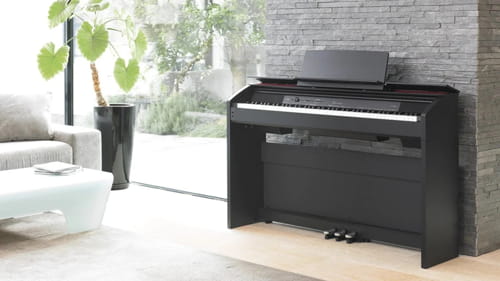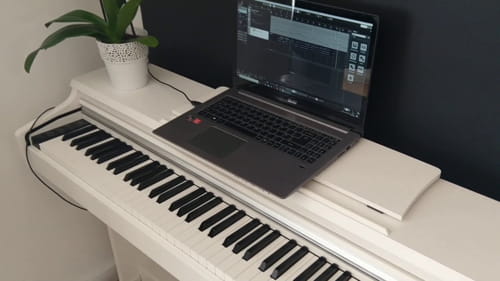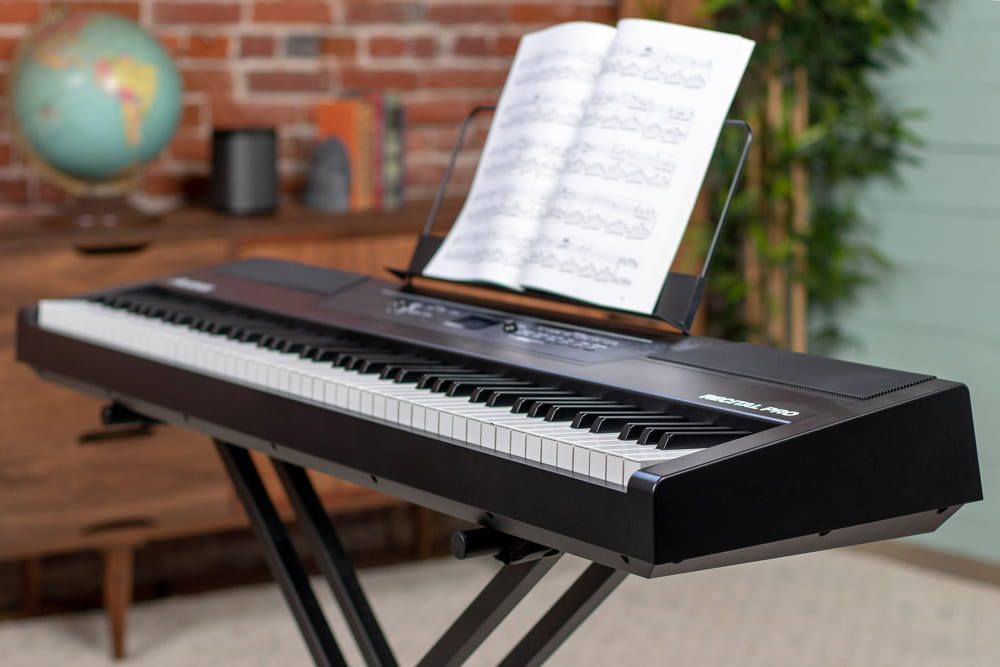You can connect your digital piano to a computer using either a MIDI interface, USB cable or just through the keyboard’s headphone output. The process is fairly simple if you can work through a bit of technicalities.
Below, we will be breaking the entire process and relevant details for you to easily connect your digital piano to your computer. So, let us get into this:
Why Should You Connect a Digital Piano to Your Computer?

There are many benefits of connecting a digital piano to your computer. Some of these are as follows:
- Firstly, using a recording software, you can record yourself playing the digital piano which is essential if you are starting our. Later, you can save it as an audio file that you can edit or share online with family and friends.
- Also, you can use digital pianos for recording MIDI data which is a standard way of transferring data to music notation software. This helps you to write down your own songs and melodies and generate your set of audio interface easily.
- Lastly, if you have been learning to play the digital piano. Your teacher might be sending you musical pieces through email or just uploads them on video hosting websites. If so, using a computer, you can play and practice those pieces downloading the MIDI files and using it with your digital piano.
Steps to Connect a Digital Piano to Computer

Before anything else, let us get ready and get all the equipment needed to make this connection:
What Do You Need?
The main things you will need are:
- A MIDI interface
- A USB cable
- Your digital piano
- Your computer
Note that whether you need a Midi cable of a USB depends on your piano model.
1 – Check Which Cable Will Plug Into Your Keyboard
Depending on the model of your keyboard, you will either need a standard MIDI cable or USB connection. The best digital pianos come with a midi keyboard. If that’s the case, you have to use the standard midi ports cable for a midi keyboard.
What is a Midi-Cable?
MIDI cables are 5-pin cables that you will need to connect to your keyboard and computer. These cables allow data transfer between the digital piano and the computer when inserted properly in the midi ports. This is why, these midi data cables are crucial for this process. You can buy these cables very easily on Amazon or any other website of your choice.
2 – Plug The Midi / USB Port Cable to Your Keyboard And Computer
Take your cable of choice and connect one end to the output socket on your keyboard or digital piano. The other end should be connected to either the USB MIDI or USB port on your computer.
3 – Turn Your Digital Piano On
Make sure that your digital piano is on and ready to connect with the computer. Even better if your digital audio workstation is all ready and has UPS connectivity.
4 – Launch Your Computer’s Software Synth & Check Device Manager
Go ahead and launch your favorite DAW software synth like Garritan or VSTi etc. Then, check your device manager whether all the necessary drivers are already installed or not.
5 – Download The Needed MIDI Drivers For Your Keyboard
Based on the model of your digital piano, you are going to need one of the different USB MIDI driver. The best way is to Google search “piano XXX drivers” where XXX stands for the name of your keyboard. Make sure to mention whether you need the drivers for iOS devices or Android devices.
6 – Open Your Digital Piano’s Connections to Your Computer
This can be done through MIDI connections or USB cables depending on what type of cable you are using.
7 – Check The Connections And Your Device Manager Once More
Make sure all the connections between your keyboard, computer and software synth are correct. Also, check once more whether all the drivers for your digital piano are properly installed in the device manager.
8 – If Needed, Configure Audio Latency in Your System
There is a chance your computer might not detect the MIDI link or it may take some time for software synths to recognize your digital piano. This can be solved by configuring audio latency in your system’s settings. Solving this issue is necessary for the transfer of a midi file.
Connecting Via Bluetooth
For most instruments, connecting via Bluetooth is not an option. However, for some digital pianos like the modern Yamaha keyboard, you can connect to your computer or tablet by using a Bluetooth MIDI-adapter. This method gives you enough freedom of movement around your studio and even outside it.
Which Connecting Method Should You Use?
There is no single answer to this question because it all depends on what suit you, but here are some suggestions:
1- Connecting Via a MIDI-interface
This may be the best solution if:
- You have an extensive set of sounds installed on your computer and you want to use them in combination with others in your digital piano
- You want to record your music on computer or if you need to use some more advanced record MIDI-software
2- Connecting Via a USB Cable
Go for this if:
- You only have pianos installed on your computer and don’t feel like installing new ones.
- You just want to practice using headphones on your computer.
3- Connecting Via The Headphone Output
This is useful if:
- You want to practice in complete silence or look forward to recording music
- You can’t connect any of the other outputs on your instrument to the computer
Tips For Connecting a Digital Keyboard to Computer
Here are a couple of things you should bear in mind:
- Always make sure that your piano is compatible with the MIDI-connection method you’ve chosen.
- If it’s a USB connection, make sure your computer has multiple USB ports. This way you’ll be able to plug both your keyboard and mouse into one single port.
- Always check if there are any speakers or an amplifier connected to your keyboard. This way you’ll be able to hear the audio output even if the connection is not established between your piano and computer.
The Takeaway
So, this pretty much sums up the whole process of connecting you’re digital piano to your PC or Mac. It is not tricky at all. All you need is some understanding of the virtual instrument working, sound module, and port and you can easily play and record music on your Android and iOS device.
Now that we’ve taken a look at all the possibilities of connecting our digital pianos to our computers, let’s give it a try and start with setting it up! We are sure you can do it easily!

